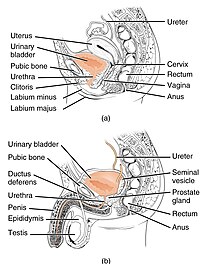
Photo from wikipedia
&NA; In a recent multicenter population pharmacokinetic study of ciprofloxacin administered to children suffering from complicated urinary tract infection (cUTI), the apparent volume of distribution (V) and total plasma clearance… Click to show full abstract
&NA; In a recent multicenter population pharmacokinetic study of ciprofloxacin administered to children suffering from complicated urinary tract infection (cUTI), the apparent volume of distribution (V) and total plasma clearance (CL) were decreased by 83.6% and 41.5% respectively, compared to healthy children. To understand these differences, a physiologically‐based pharmacokinetic model (PBPK) for ciprofloxacin was developed for cUTI children. First, a PBPK model in adults was developed, modified incorporating age‐dependent functions and evaluated with paediatric data generated from a published model in healthy children. Then, the model was then adapted to a cUTI paediatric population according to the degree of renal impairment (KF) affecting renal clearance (CLRenal,) and CYP1A2 clearance (CLCYP1A2). Serum and urine samples obtained from 22 cUTI children were used for model evaluation. Lastly, a parameter sensitivity analysis identified the most influential parameters on V and CL. The PBPK model predicted the ciprofloxacin exposure in adults and children, capturing age‐related pharmacokinetic changes. Plasma concentrations and fraction excreted unchanged in urine (fe) predictions improved in paediatric cUTI patients once CLrenal and CLCYP1A2 were corrected by KF. The presented PBPK model for ciprofloxacin demonstrates its adequacy to simulate different dosing scenarios to obtain PK predictions in a healthy population from 3 months old onwards. Model adaptation of CLRenal and CLCYP1A2 according to KF explained partially the differences seen in the plasma drug concentrations and fe vs time profiles between healthy and cUTI children. Nevertheless, it is necessary to further investigate the disease‐related changes in cUTI to improve model predictions.
Journal Title: European Journal of Pharmaceutical Sciences
Year Published: 2019
Link to full text (if available)
Share on Social Media: Sign Up to like & get
recommendations!